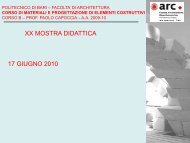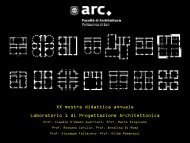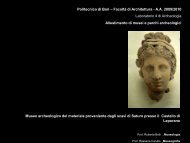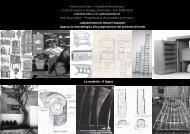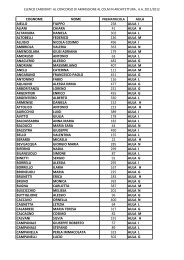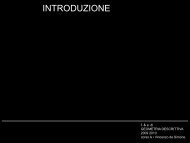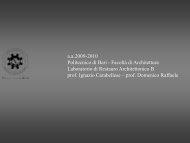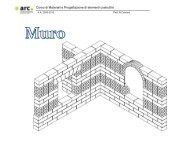44. I regolamenti <strong>di</strong>dattici140Laboratorio <strong>di</strong> Disegno industriale 1/IIIndustrial Design Stu<strong>di</strong>o 1/IILDI 1/II-7,5 cfu1° anno / corso semestrale (II semestre)Area <strong>di</strong>dattica I:Progetto del prodotto industriale:• Icar 13, Disegno industriale• Icar 16, Architettura degli interniCarmine PappalettereDisegno industriale 1/II (Icar 13-5 cfu)Anna CajatiRealizzazione del prodotto industriale (Icar12-2,5 cfu)Finalità e contenuti <strong>di</strong>sciplinariIl corso è rivolto principalmente asperimentare applicazioni progettuali delleconoscenze acquisite nel precedenteLaboratorio 1/I <strong>di</strong> Disegno industriale.Aims and contentsThe course mainly focuses on experimenaltdesign applications of the knowledgeacquired in the previous Stu<strong>di</strong>o 1/I.Articolazione delle attività <strong>di</strong>datticheLe lezioni ex cathedra analizzeranno lelinee evolutive <strong>di</strong> alcuni materiali e ne<strong>il</strong>lustreranno i processi <strong>di</strong> lavorazione efinitura, nonché applicazioni a casistichesignificative, sia in termini <strong>di</strong> innovazionedel prodotto industriale, sia in termini <strong>di</strong>organizzazione, razionalizzazione edottimizzazione delle prestazioni deisistemi produttivi.In particolare saranno affrontati i seguentiargomenti:• materiali per la produzione ed<strong>il</strong>izia el’arredo urbano nei sistemi produttivi abasso tasso <strong>di</strong> industrializzazione: pietre emarmi; laterizi;-materiali nei sistemi produttivi ad altotasso <strong>di</strong> industrializzazione: <strong>il</strong> legno(nell’ed<strong>il</strong>izia e nella produzione <strong>di</strong> oggettid’arredo), gli acciai, l’alluminio; materieplastiche, <strong>il</strong> vetro, carte e cartoni.La sperimentazione progettuale saràapplicata a sistemi <strong>di</strong> oggetti <strong>di</strong> produzioneindustriale, tra le quali:• design <strong>di</strong> sistemi <strong>di</strong> rubinetteria per bagnie cucine;• design <strong>di</strong> sistemi <strong>di</strong> <strong>il</strong>luminazione peresterni.Articulation of the educational activitiesThe lessons analyze the evolutionary linesof some material and <strong>il</strong>lustrate significantprocesses in their production, as well asapplications, both in terms of innovation ofthe industrial product, and in terms oforganization, rationalization andoptimization of the performance of theproduction systems.The following topics are covered:• materials for bu<strong>il</strong><strong>di</strong>ng production andurban furniture in productione systemswith a low rate of industrialization: stoneand marble; ceramic t<strong>il</strong>es;• materials in the productive systems witha high rate of industrialization: wood (inhouse bu<strong>il</strong><strong>di</strong>ng and in the production offurniture), steel, aluminium; plastics, glass,paper and cardboard.The project experimentation w<strong>il</strong>l be appliedto systems of objects of industrialproduction, such as:• design of top systems for baths andkitchens;• design of exterior lighting systems.Iscrizione al corsoLe iscrizioni avvengono obbligatoriamentesulla piattaforma e-learning entro i primi<strong>di</strong>eci giorni dall’inizio dei corsi.Modalità d’esameL’esame consisterà in un colloquio sui temiesposti delle lezioni e sugli L’esame sibaserà sulla valutazione del grado <strong>di</strong>conoscenza raggiunto dallo studente inmerito ai temi trattati nel corso, edocumentati nella “Bibliografia” allegata aprogramma particolareggiato e nei“Complementi <strong>di</strong> tecnologia per <strong>il</strong> CdL inDisegno industriale” (consegnati nelcorso). Si baserà inoltre sulla valutazionedel grado <strong>di</strong> interesse, <strong>di</strong> competenza e <strong>di</strong>compiutezza riscontrati nelle esercitazionisvolte.Laboratorio <strong>di</strong> Progettazione grafica 1/IIGraphic Design Stu<strong>di</strong>o 1/IILPG 1/II-7,5 cfu1° anno / corso semestrale (II semestre)Area <strong>di</strong>dattica I:Progetto del prodotto industriale:• Icar 13, Disegno industriale• Icar 16, Architettura degli interniFranco AltobelliProgettazione grafica 1/II (Icar 13-5 cfu)Leonardo DirenzoCultura tecnologica della progettazionegrafica (Icar 12-2,5 cfu)Finalità e contenuti <strong>di</strong>sciplinariIl laboratorio ha l’obiettivo <strong>di</strong> introdurre glistudenti del primo anno <strong>di</strong> corso alleproblematiche generali del progetto <strong>di</strong>comunicazione visiva.Le lezioni verteranno sui seguentiargomenti:• La nozione <strong>di</strong> sistema grafico:rappresentazione e raffigurazione; i segniper la comunicazione; sistemi coerenti;co<strong>di</strong>ci aperti e co<strong>di</strong>ci chiusi.• La scrittura: lingua e scrittura; scritturealfabetiche e non alfabetiche; scritture nonorientate alla lingua.• La percezione: costanti fisiologiche evariab<strong>il</strong>i culturali; visib<strong>il</strong>ità e leggib<strong>il</strong>ità; ifattori <strong>di</strong> scala; <strong>il</strong> colore; <strong>il</strong> movimento.• Introduzione alla tipografia: la tipografiacome varietà della scrittura per laproduzione industriale; la tipografia comesistema progettuale; tipografia <strong>di</strong>gitale eco<strong>di</strong>ce Unicode.• Grafica e tipografia: da Gutenberg alla
fine dell’Ottocento; le avanguar<strong>di</strong>e delNovecento; Jan Tschichold e AnthonyFroshaug; scritture <strong>di</strong>gitali nontipografiche.• Rappresentazioni <strong>di</strong>agrammatiche:sistemi per la rappresentazione <strong>di</strong>informazioni quantitative e qualitative;rappresentazioni analitiche e sintetiche;rappresentazione <strong>di</strong> fenomeni <strong>di</strong>namici.• L’organizzazione dello spazio: sistemi <strong>di</strong>impaginazione, sistemi <strong>di</strong> relazioni; grigliee gabbie; dai supporti bi<strong>di</strong>mensionale finitialle reti virtuali; sistemi <strong>di</strong>namici.Aims and contentsThe target of the course is to introduce thestudents to the general problems of aproject of visual communication.The lessons concern the following topics:• The notion of a graphic system:representation and figuration; the signs forcommunication; coherent systems; openand closed codes.• Writing: language and writing;alphabetical and not alphabetical writing;writing not <strong>di</strong>rected to language.• Perception: physiological constants andcultural variations; visib<strong>il</strong>ity and legib<strong>il</strong>ity;scale factors; colour; movement.• Introduction to typography: typographyas a variety of writing for industrialproduction; typography as a projectsystem; <strong>di</strong>gital typography and Unicode.• Graphics and typography: fromGutenberg to the end of the nineteenthcentury; the nineteenth century avantgarde;Jan Tschichold and AnthonyFroshaug; non-typographic <strong>di</strong>gital writing.• Diagramatic representations: systems forthe representation of quantitative andqualitative information; analytical andsynthetic representations; representationof dynamic phenomena.• Organization of space: systems ofpagination, systems of relationships; gr<strong>il</strong>lsand cages; from the two-<strong>di</strong>mensionalended supports to virtual nets; dynamicsystems.Articolazione delle attività <strong>di</strong>datticheVerranno <strong>di</strong>stribuiti materiali <strong>di</strong>datticispecifici e ospiti esterni terranno lezioni oworkshop.Gli argomenti trattati saranno seguiti daesercitazioni estemporanee da parte deglistudenti.Articulation of the educational activitiesIn ad<strong>di</strong>tion to lessons, lectures w<strong>il</strong>l be givenby external guests.The acquisition of knowledge w<strong>il</strong>l befollowed by exercises and workshops.Iscrizione al corsoLe iscrizioni avvengono obbligatoriamentesulla piattaforma e-learning entro i primi<strong>di</strong>eci giorni dall’inizio dei corsi.Modalità d’esameUn’esercitazione finale costituirà la provad’esame.Storia delle arti decorative eindustriali 1/IIHistory of Decorative and Industrial Arts1/IIIcar 18-5 cfu1° anno / corso semestrale (II semestre)Area <strong>di</strong>dattica II:Storia delle forme del prodotto industriale:• Icar 18, Storia dell’architettura• L-Art 02, Storia dell’arte moderna• L-Art 03, Storia dell’arte contemporaneaAnnalinda NegliaFinalità e contenuti <strong>di</strong>sciplinariIl corso ha l’obiettivo <strong>di</strong> fornire gli elementiconoscitivi e gli strumenti critici per lacomprensione della storia del prodottoindustriale, <strong>di</strong> arredo e della grafica apartire dalla rivoluzione industriale fino alprimo ventennio del Novecento. Specificaattenzione verrà posta alla identificazionedelle posizioni teoriche delle <strong>di</strong>verse scuoleo movimenti che hanno caratterizzato <strong>il</strong>passaggio dall’arte applicata allaproduzione in serie: <strong>il</strong> processo <strong>di</strong>trasformazione delle tecniche industriali,del gusto e delle teorie progettuali verràanalizzato ut<strong>il</strong>izzando come strumento d<strong>il</strong>avoro i manifesti <strong>di</strong> scuole e movimentiquali Wiener Werkstätte, DeutscheWerkbund, Arbeitsrait für Kunst, Bauhaus ele posizioni teoriche dei designer.Aims and contentsThe aim of the course is to providestudents cognitive elements and criticaltools for the comprehension of the historyof the product of industrial, interior, andgraphic design from the age of theIndustrial Revolution to the ‘20s of lastcentury.Particular attention w<strong>il</strong>l be paid to the<strong>di</strong>fferent theoretical positions of schoolsand movements that led from applied artsto serial production. The process oftransformation of the industrial techniques,of the taste and of design theories w<strong>il</strong>l beanalyzed using as a working tool manifestosof schools and movements such as WienerWerkstätte, Deutsche Werkbund, Arbeitsraitfür Kunst, Bauhaus, plus the theoreticalposition of designers.Articolazione delle attività <strong>di</strong>datticheL’attività del corso è articolata in tre perio<strong>di</strong>relativi alle tre fasi principali che hannocaratterizzato <strong>il</strong> processo del passaggiodall’arte applicata alla produzione in serie:1. La rivoluzione industriale e le Arts andCrafts-Arte decorativa e arte industrialenell’epoca della sua riproducib<strong>il</strong>ità tecnica-La rivolta verso in nuovi sistemi industriali:W<strong>il</strong>liam Morris e <strong>il</strong> movimento delle Arts & Crafts-Grafica e comunicazione visiva tra <strong>il</strong> XVIII e<strong>il</strong> XIX secolo2. La nascita del prodotto industriale-I mob<strong>il</strong>i Thonet come mob<strong>il</strong>i brevettati in serie-Il design e la grafica nel periodo Liberty-La nascita del <strong>di</strong>segno industriale: WienerWerkstätte; Deutsche Werkbund;Arbeitsrait für Kunst; USA3. La produzione artistica industrialeIl Bauhaus: l’affermazione del concetto <strong>di</strong>standard-Il design e la grafica del MovimentoModerno44.3.20 Progetti <strong>di</strong>dattici 1° anno141
- Page 1:
0607Politecnico di BariFacoltà di
- Page 4 and 5:
Politecnico di Bari, Facoltà di Ar
- Page 6 and 7:
4. Regolamenti didattici4.1. Il Reg
- Page 8 and 9:
PresentazionePresentazioneLa Facolt
- Page 11 and 12:
Le strutture didattiche e di suppor
- Page 13 and 14:
giorno e dando, quindi, esecutivit
- Page 15 and 16:
• esprimere pareri sui compiti di
- Page 17 and 18:
1.3. La Biblioteca di FacoltàIl pa
- Page 19 and 20:
2. Strutture di ricerca e di suppor
- Page 21 and 22:
BIO 07, Ecologia43 Mariavaleria Min
- Page 23 and 24:
le richieste e le iniziative ad ess
- Page 25:
2.3 Le biblioteche d’area2.3.1 Le
- Page 28 and 29:
33. La didattica e gli studenti263.
- Page 31 and 32:
4. I Regolamenti didattici4.1. Rego
- Page 33 and 34:
presente regolamento;• le propede
- Page 35 and 36:
discussi ed i voti finali.Per ciasc
- Page 37 and 38:
4.2.4 Definizione delle aree discip
- Page 39 and 40:
laurea da attivare in base al numer
- Page 41 and 42:
non venga superato l’iscrizione a
- Page 43 and 44:
Manifesto del CdLs in Architettura
- Page 45 and 46:
Manifesto del CdLm in Architettura
- Page 47 and 48:
ciclo provenendo da altri Atenei.È
- Page 49 and 50:
Manifesto del CdLs in Architettura
- Page 51 and 52:
Manifesto del CdLm in Architettura
- Page 53 and 54:
Insegnamenti ssd Crediti Laboratori
- Page 55 and 56:
Insegnamenti ssd Crediti Laboratori
- Page 57 and 58:
Insegnamenti attivati e docenti per
- Page 59 and 60:
Insegnamenti attivati e docenti per
- Page 61 and 62:
Finalità e contenuti disciplinariN
- Page 63 and 64:
Lezioni- L’architettura etrusca e
- Page 65 and 66:
ibliografiche, volte ad acquisire g
- Page 67 and 68:
Discipline tecnologiche per l’Arc
- Page 69 and 70:
Istituzioni di geometria I + Istitu
- Page 71 and 72:
architettonicoTopicsLife drawing, u
- Page 73 and 74:
• Representation of the shadows
- Page 75 and 76:
frequenza del corso che consentel
- Page 77 and 78:
capacità di valutazione storico-cr
- Page 79 and 80:
scale edilizie e tra diversi tipi;
- Page 81 and 82:
planning of Roman suburban andcount
- Page 83 and 84:
mutation through the works of the p
- Page 85 and 86:
-Equazioni indefinite di equilibrio
- Page 87 and 88:
coerenza tra qualità funzionale, c
- Page 89 and 90:
transformations (psychrometry).In t
- Page 91 and 92: madrepatria.4. La colonizzazione e
- Page 93 and 94: EtruscologiaEtruscologyL-ANT/07 - 4
- Page 95 and 96: Archeologia e Storia dell’Arte Ro
- Page 97 and 98: The student will develope the archi
- Page 99 and 100: tanto il rapporto tra elementi, str
- Page 101 and 102: sociale dell’abitare (Loos, Tesse
- Page 103 and 104: experimental research into the beha
- Page 105 and 106: Articolazione dell’attività dida
- Page 107 and 108: Aims and contentsThe Urban Sociolog
- Page 109 and 110: nell’ambito dell’annuale “mos
- Page 111 and 112: di laurea. Sarà quindi necessario
- Page 113 and 114: - Ancient modern Rome: the continui
- Page 115 and 116: During the lessons, theoretical and
- Page 117 and 118: Le esercitazioni costituiscono lo s
- Page 119 and 120: typological and technical innovatio
- Page 121 and 122: • la fenomeni di propagazione del
- Page 123 and 124: Aims and contentsThe urban economy,
- Page 125 and 126: value of a civil apartment with the
- Page 127 and 128: l’elaborazione della tesi di rice
- Page 129 and 130: 4.3.8 Esame di laureaPer essere amm
- Page 131 and 132: semestrale• Laboratori di sintesi
- Page 133 and 134: 4.3.14 Manifesto del CdL in Disegno
- Page 135 and 136: 4.3.16 Organizzazione delle attivit
- Page 137 and 138: 4.3.17 Insegnamenti e docenti per a
- Page 139 and 140: Laboratorio di Disegno industriale
- Page 141: • metodo dell’assonometria;•
- Page 145 and 146: Iscrizione al corsoLe iscrizioni av
- Page 147 and 148: Laboratorio di Arredamento 2/IInter
- Page 149 and 150: Disegno 2/IIDrawing 2/IIIcar 17-5 c
- Page 151 and 152: communication, as follows:• typog
- Page 153 and 154: 4.3.22 Progetti didattici3° anno
- Page 155 and 156: sintetiche, segnaletica interna ed
- Page 157: esercitazioni pratiche, attività d
- Page 160 and 161: 55. Relazioni internazionali1585.1
- Page 163 and 164: 6. Post Lauream6.1. Dottorato di Ri
- Page 165 and 166: Attività di ricercaLo svolgimento
- Page 167 and 168: particolari e specifiche competenze
- Page 169 and 170: iscrizione all’esame di ammission
- Page 171 and 172: scientifico-disciplinare in cui è
- Page 173: • alla sicurezza statica (corrett
- Page 176 and 177: a.1 Planimetria del campus epiante
- Page 178 and 179: Status accademico dei docentiDocent
- Page 180 and 181: aAppendici178A.3 Indice dei nomiAAc
- Page 182 and 183: aAppendicia.5 Calendario annuale de




